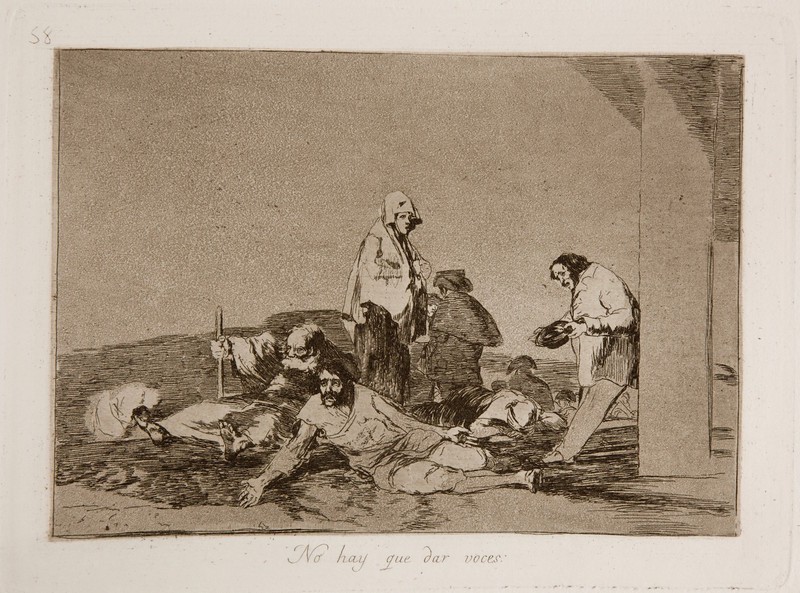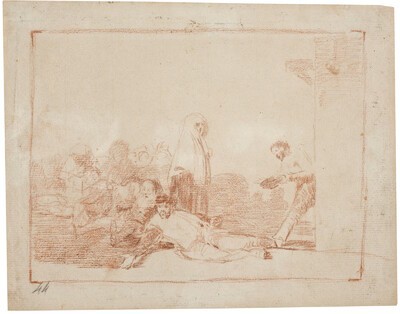- Cronología
- Ca. 1812 - 1815
- Dimensiones
- 157 x 211 mm
- Técnica y soporte
- Aguafuerte, aguatinta bruñida, buril y bruñidor
- Reconocimiento de la autoría de Goya
- Undisputed work
- Ficha: realización/revisión
- 03 Feb 2013 / 02 Jun 2023
- Inventario
- 225
34 (on the lower left-hand corner of the plate).
See Sad presentiments of what must come to pass.
The second artist's proof shows that the right-hand side of the skirt worn by the central standing figure and the left shoulder of the man closest to the viewer were retouched with burin. The aquatint details on the back and upper parts of the standing figure were also burnished.
The title was handwritten on the print by Goya in the first and only series that is known to have been printed at the time the works were created, which the artist gave to his friend Agustín Ceán Bermúdez. Therefore, the title was etched into the plate at a later date and left unchanged as of the first edition of the Disasters of War printed by the San Fernando Royal Academy of Fine Arts in Madrid in 1863, after the printing of the series in the possession of Ceán Bermúdez.
There is a surviving preparatory drawing for this print which is housed in the Prado Museum in Madrid.
In this print Goya sets up a contrast between the elegantly dressed French soldiers in the background - one of whom is wearing a top hat while the other located further in the background wears a fashionable bicorne hat - and the tragic poverty of the skeletal figures begging for help in the foreground. One of the starving figures leans on the wall, extending a hat in a request for alms. In the centre of the composition a woman whose head is covered gazes into the distance with a lost expression, while in the foreground of the print two dying men make desperate pleas for help.
According to Hofmann, the bearded men in the foreground bear a similarity to the vagrant philosophers depicted by Goya, such as Diogenes in You will not find him (No lo encontraras) from Album C. Moreover, the figure leaning on the post is reminiscent of the injured man depicted in Caprice no. 10, Love and death (El amor y la muerte).
As suggested by Juan Carrete, this print can be interpreted as a variation on print no. 54, Appeals are in vain (Clamores en vano), which deals with the same subject. In both cases, the works' titles and images express the same concept: the futility of asking for help and the impassive coldness of the French soldiers, indifferent to the suffering of the starving.
The plate is stored in the National Chalcography (cat. 309).
-
Goya. Das Zeitalter der Revolucionen. Kunst um 1800 (1980 – 1981)Hamburger KunsthalleHamburg1980cat. 92
-
Francisco de GoyaMuseo d'Arte ModernaLugano1996exhibition celebrated from September 22nd to November 17th.p. 175, cat. 58
-
Francisco Goya. Sein leben im spiegel der graphik. Fuendetodos 1746-1828 Bordeaux. 1746-1996Galerie KornfeldBern1996from November 21st 1996 to January 1997cat. 142
-
Ydioma universal: Goya en la Biblioteca NacionalBiblioteca NacionalMadrid1996from September 19th to December 15th 1996cat. 219
-
Francisco Goya. Capricci, follie e disastri della guerraSan Donato Milanese2000Opere grafiche della Fondazione Antonio Mazzottacat. 138
-
Goya. Opera graficaPinacoteca del Castello di San GiorgioLegnano2006exhibition celebrated from December 16th 2006 to April 1st 2007p. 80
-
Goya et la modernitéPinacothèque de ParisParís2013from October 11st 2013 to March 16th 2014cat. 97
-
Goya, grabadorMadridBlass S.A.1918cat. 160
-
Goya engravings and lithographs, vol. I y II.OxfordBruno Cassirer1964cat. 178
-
Vie et ouvre de Francisco de GoyaParísOffice du livre1970cat. 1090
-
Catálogo de las estampas de Goya en la Biblioteca NacionalMadridMinisterio de Educación y Cultura, Biblioteca Nacional1996cat. 270
-
Goya. Die Kunst der FreiheitMunichVerlag C. H. Beck2000p. 153, fig. 58
-
ParísPinacoteca de París2013p. 148
-
Goya. In the Norton Simon MuseumPasadenaNorton Simon Museum2016pp. 114-151

